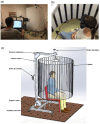Optokinetic After-Nystagmus: A Marker for Migraine? A Prospective Observational Study
- PMID: 39829013
- PMCID: PMC11744620
- DOI: 10.1177/19160216241307553
Optokinetic After-Nystagmus: A Marker for Migraine? A Prospective Observational Study
Abstract
Introduction: Vestibular migraine (VM), particularly its chronic variant, poses a diagnostic challenge. Patients suffering from VM may not have the characteristic headaches associated with the dizziness. In these cases, a marker for migraine pathology in general could help appropriately diagnose certain types of dizziness as migrainous despite these patients not meeting current diagnostic criteria for VM. Migraine patients in general (headache and vestibular) are known to share a tendency toward intolerance of certain stimuli, including busy visual stimuli. True optokinetic stimulation, measured by the production of optokinetic after-nystagmus (OKAN) simulates these busy visual stimuli.
Methods: Prospective observational study comparing response to optokinetic stimulation between migraine patients and controls. Questionnaires regarding general sensitivities to busy visual stimuli were completed prior to beginning the study. Both subjective and objective markers of stress were measured before and after exposure to the stimulus. Initial slow-phase velocity, slow cumulative eye position, and adjusted time constant of OKAN were compared between the 2 groups.
Results: The groups differed only with regard to sensitivity to blinking lights and history of motion sickness on initial questionnaire. Regarding subjective symptoms of discomfort, migraine patients tended to report higher scores than controls both before and after testing, but there was no significant difference from before to after stimulus in each group's scores. There were no statistically-significant differences between initial slow-phase velocity, slow cumulative eye position, and adjusted time constant of OKAN between groups.
Conclusions: In this study, OKAN measurements were not useful in differentiating migraine patients at large from control subjects. We hypothesize that there may be a distinct subgroup of migraine patients that are more sensitive to visually-disturbing situations that may differ from other migraine sufferers. Future studies will aim to identify such patients and compare them to controls.
Keywords: OKAN; migraine; migraine-related dizziness; migrainous vertigo; optokinetic after-nystagmus; vestibular migraine.
Conflict of interest statement
Declaration of Conflicting InterestsThe author(s) declared no potential conflicts of interest with respect to the research, authorship, and/or publication of this article.
Figures




Similar articles
-
Return to Running After Achilles Tendon Repair: How Do US Navy Service Members' Physical Readiness Tests Change After Undergoing an Achilles Tendon Repair?Clin Orthop Relat Res. 2025 Jun 18. doi: 10.1097/CORR.0000000000003590. Online ahead of print. Clin Orthop Relat Res. 2025. PMID: 40536551
-
Use of β-adrenoreceptor drugs and Parkinson's disease incidence in women from the French E3N cohort study.J Parkinsons Dis. 2025 Jun;15(4):789-804. doi: 10.1177/1877718X251330993. Epub 2025 Apr 29. J Parkinsons Dis. 2025. PMID: 40302366
-
Pharmacological and electronic cigarette interventions for smoking cessation in adults: component network meta-analyses.Cochrane Database Syst Rev. 2023 Sep 12;9(9):CD015226. doi: 10.1002/14651858.CD015226.pub2. Cochrane Database Syst Rev. 2023. PMID: 37696529 Free PMC article.
-
Clinical Features of Migraine, Vestibular Migraine, and Tension-Type Headache and Their Vestibular Evoked Myogenic Potential Study.J Clin Med Res. 2025 Jun 30;17(6):344-355. doi: 10.14740/jocmr6185. eCollection 2025 Jun. J Clin Med Res. 2025. PMID: 40641859 Free PMC article.
-
Prenatal administration of progestogens for preventing spontaneous preterm birth in women with a multiple pregnancy.Cochrane Database Syst Rev. 2019 Nov 20;2019(11):CD012024. doi: 10.1002/14651858.CD012024.pub3. Cochrane Database Syst Rev. 2019. PMID: 31745984 Free PMC article.
Cited by
-
Beyond the Headache: Autonomic Reflex Dysfunction and Sensory Hypersensitivity Contribute to Orthostatic Intolerance in Migraine.Res Sq [Preprint]. 2025 Jun 16:rs.3.rs-6847469. doi: 10.21203/rs.3.rs-6847469/v1. Res Sq. 2025. PMID: 40585261 Free PMC article. Preprint.
References
-
- Burch RC, Loder S, Loder E, Smitherman TA. The prevalence and burden of migraine and severe headache in the United States: updated statistics from government health surveillance studies. Headache. 2015;55:21-34. - PubMed
-
- Ramage-Morin PL, Gilmour H. Prevalence of migraine in the Canadian household population. Health Rep. 2014;25(6):10-16. - PubMed
-
- Kayan A, Hood JD. Neuro-otological manifestations of migraine. Brain. 1984;107:1123-1142. - PubMed
-
- Drummond PD. Motion sickness and migraine: optokinetic stimulation increases scalp tenderness, pain sensitivity in the fingers and photophobia. Cephalalgia. 2002;22(2):117-124. - PubMed
-
- Drummond PD, Granston A. Facial pain increases nausea and headache during motion sickness in migraine sufferers. Brain. 2004;127(3):526-534. - PubMed
Publication types
MeSH terms
LinkOut - more resources
Full Text Sources
Medical

